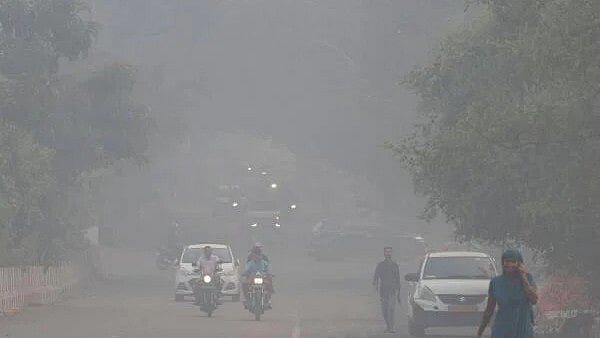
Vehicles move on a road shrouded in smog on the morning of Diwali in Delhi.
Credit: Reuters Photo
New Delhi: Delhi on Monday, the day of Diwali woke up to 'very poor' air quality even as the Commission for Air Quality Management (CAQM) has invoked Stage II of the Graded Response Action Plan (GRAP) across Delhi-NCR.
According to the SAMEER app by the Central Pollution Control Board (CPCB), Delhi recorded an overall AQI of 339 at 9 am. Data from around 38 monitoring stations showed that most parts of the city reported air quality levels above 300.
Anand Vihar recorded an AQI of 414, and Wazirpur 412, both being among the stations where air quality remained in the "severe" category.
The Centre's air quality panel also asked all implementing agencies to keep strict vigil, particularly on dust mitigation and to ensure compliance with targeted timelines laid down under the comprehensive policy to curb air pollution in NCR.
Under Stage II of GRAP, several curbs and intensified actions include daily mechanical or vacuum sweeping and water sprinkling on identified roads, preferably before peak traffic hours, to control dust.
Construction and demolition sites face intensified inspections to ensure strict enforcement of dust control measures.
To promote cleaner mobility, the GRAP Stage II mandates augmentation of public transport services through additional CNG and electric buses and increased frequency of metro services, along with differential fare rates to encourage off-peak travel.
Resident welfare associations (RWAs) are required to provide electric heaters to staff such as guards, gardeners and sanitation workers to prevent open burning of biomass and solid waste during winters.
Entry of inter-state buses into Delhi is restricted to those running on CNG, EVs or BS-VI diesel, excluding tourist buses operating under all-India permits.
GRAP categorises air quality into four stages: Stage I (Poor) with AQI between 201 and 300, Stage II (Very Poor) between 301 and 400, Stage III (Severe) between 401 and 450, and Stage IV (Severe Plus) for AQI above 450.
Unfavourable meteorological conditions, combined with vehicular emissions, paddy-straw burning, firecrackers and other local pollution sources, contribute to hazardous air quality levels in Delhi-NCR during winters.
An AQI between 0 and 50 is considered "good", 51 to 100 "satisfactory", 101 to 200 "moderate", 201 to 300 "poor", 301 to 400 "very poor", and 401 to 500 "severe".
The IMD has predicted fog mist in the morning and mainly clear sky later in the day.
The maximum temperature is expected to be 33 degrees Celsius.
